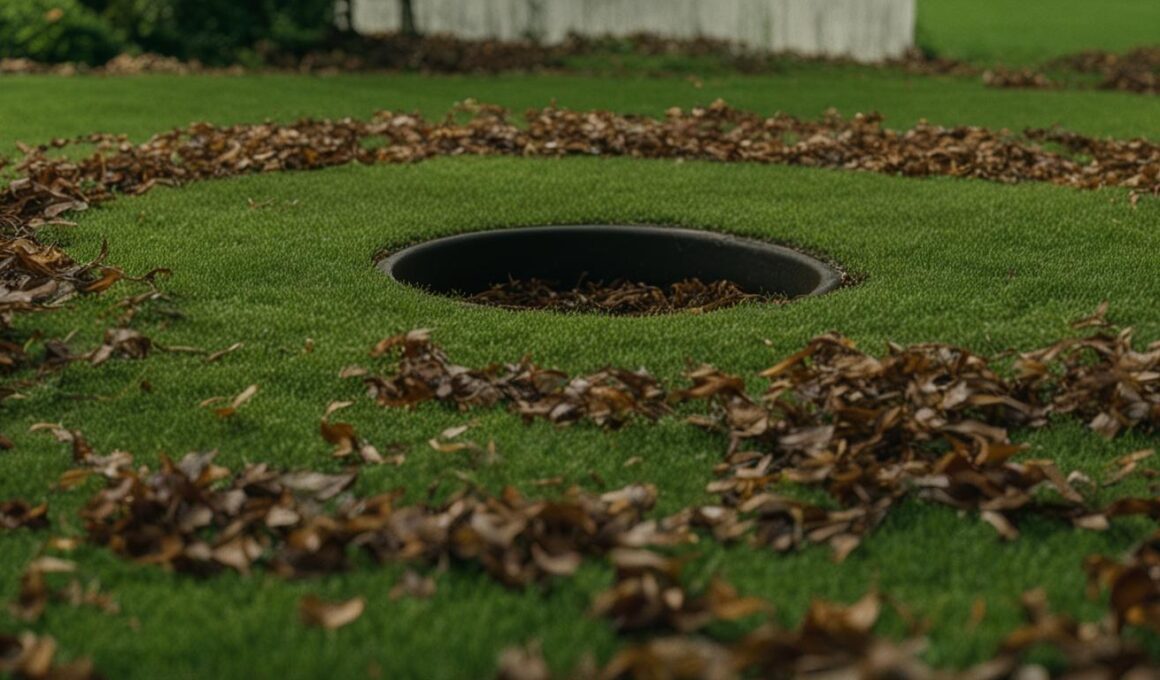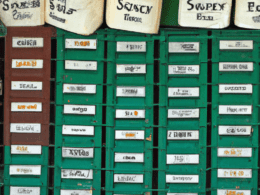Excess iron in lawn irrigation can have detrimental effects on your lawn and irrigation system. It is important to be aware of the hazards of having too much iron in your lawn and take appropriate measures to maintain a healthy and vibrant lawn.
Iron is a naturally occurring element found in soil and rocks, and it can accumulate in groundwater. When iron levels in your lawn exceed the optimal range, it can lead to cosmetic problems and damage to your irrigation system.
Lab tests used to measure iron concentrations in irrigation water can sometimes be misleading, so it is crucial to analyze water samples under the right conditions. High iron levels in irrigation water can result in staining of concrete surfaces, clogging of irrigation equipment and drainage tiles, and unsightly rust-colored deposits on plants.
Biofouling, which is the result of bacterial growth in low oxygen conditions, can also occur when there are high concentrations of iron in the water. This can further reduce the efficiency of your irrigation system and create unpleasant odors.
To prevent these hazards and maintain a healthy lawn, treatment of irrigation water containing excess iron involves oxidizing the iron before it reaches the irrigation system and ensuring proper filtration to prevent clogging.
Post Summary
- Excessive iron in lawn irrigation water can lead to staining of concrete surfaces and clogging of irrigation equipment.
- High iron levels in irrigation water can cause unsightly rust-colored deposits on plants.
- Biofouling, resulting from high iron concentrations in water, can reduce the efficiency of your irrigation system.
- Treatment of irrigation water involves oxidizing the iron and implementing proper filtration.
- Analyze water samples under appropriate conditions to accurately measure iron concentrations in irrigation water.
Benefits of Using Iron in Lawn Care
If you want to keep your lawn looking vibrant and healthy, incorporating iron supplements into your lawn care routine can provide numerous benefits. Iron plays a crucial role in promoting the overall health of your grass and can help address common lawn issues. Here are some of the key benefits of using iron in lawn care:
- Enhanced Grass Color: Iron boosts photosynthesis in plants, resulting in a lush, vibrant green color for your grass. Adding iron to your lawn can help you achieve that desired, eye-catching appearance.
- Improved Resistance to Pests and Diseases: Iron strengthens the turf and enhances the health of the grass roots, making your lawn more resilient to pests and diseases. This can help prevent damage and ensure the longevity of your lawn.
- Control of Moss Growth: Moss can be a common issue in lawns, especially in shaded areas with excess moisture. Iron can help control moss growth and promote a healthier, moss-free lawn.
Quote: “Iron supplements can significantly improve the color and health of your lawn. By strengthening the grass and making it more resistant to pests and diseases, iron acts as a natural health booster for your lawn.” – Lawn Care Expert
However, it’s important to apply iron supplements in moderation and follow the recommended guidelines. Excessive application can lead to issues such as burning and discoloration of the grass, low soil pH levels, and biofouling of irrigation systems. By using iron properly, you can achieve a balanced and thriving lawn that will be the envy of your neighborhood.
| Benefits | Effects |
|---|---|
| Enhanced Grass Color | Vibrant green appearance |
| Improved Resistance to Pests and Diseases | Less damage from pests and diseases |
| Control of Moss Growth | Reduced presence of moss in the lawn |
Remember to consult with professionals and conduct soil tests to determine the specific iron supplementation needs of your lawn. By incorporating iron into your lawn care routine, you can ensure a beautiful, healthy, and resilient lawn all year round.
Potential Problems of Too Much Iron in the Lawn
While iron is beneficial for lawn care, excessive application can lead to problems. Over-application of iron can cause burning and discoloration of the grass, turning it yellow or black. It can also result in low soil pH levels, which can affect the grass’s ability to absorb other essential nutrients. Burnt grass blades are another sign of iron overdose in the lawn, especially in hot and rainy weather.
Additionally, high iron concentrations can contribute to the biofouling of irrigation systems, leading to reduced efficiency and unpleasant odors. Addressing these issues may involve applying lime to neutralize acidity, washing away excess iron, adding bicarbonates to the soil, applying zinc and molybdenum, and improving lawn drainage. These measures can help restore the health and appearance of your lawn.
| Potential Problems of Too Much Iron in the Lawn | Symptoms | Solutions |
|---|---|---|
| Grass burning and discoloration | Yellow or black grass, burnt grass blades | Wash away excess iron, improve lawn drainage |
| Low soil pH levels | Impaired nutrient absorption | Apply lime to neutralize acidity, add bicarbonates to the soil |
| Biofouling of irrigation systems | Reduced efficiency, unpleasant odors | Apply zinc and molybdenum, ensure proper filtration |
It’s important to be cautious with iron application and follow the recommended guidelines to avoid these potential problems. Before applying any treatments, consider conducting soil tests to determine the specific needs of your lawn. Seeking professional advice can also provide valuable insights and guidance for maintaining a healthy, vibrant lawn.
Diagnosing and Treating Iron Deficiency in the Lawn
Iron deficiency in your lawn can have detrimental effects on its overall health and appearance. If you notice yellowing grass blades and a poorly established turf, it’s crucial to diagnose and treat the iron deficiency promptly. Conducting soil tests is the first step towards identifying the issue and determining the appropriate course of action.
By analyzing the iron levels in your lawn’s soil, you can pinpoint if iron deficiency is indeed the problem. Soil tests will also help uncover any other underlying issues that may be causing the nutrient imbalance in your lawn. It’s important to remember that iron deficiency can be a symptom of other problems, such as poor soil drainage or high pH levels.
If iron deficiency is confirmed, applying iron supplements to your lawn can help restore its health and vibrancy. There are different types of iron fertilizers available, such as ferrous sulfate and chelated iron, each with their own benefits and limitations. It’s crucial to follow the recommended guidelines and mix the iron application with fertilizer for optimal results. The frequency of iron application will depend on factors such as the soil’s iron content and pH levels, as well as the specific needs of your plants.
Remember to consult with a lawn care professional or your local extension office to ensure you are accurately diagnosing and treating the iron deficiency in your lawn. Their expertise will help guide you in choosing the right iron supplements and developing a comprehensive lawn care plan. With proper care and attention, you can effectively address iron deficiency and restore your lawn to its lush green glory.
Iron Supplements for Lawn Care
| Iron Supplement | Benefits | Limitations |
|---|---|---|
| Ferrous Sulfate | Quick and cost-effective solution | Can stain concrete surfaces if not applied correctly |
| Chelated Iron | Provides long-lasting results | More expensive compared to ferrous sulfate |
| Iron Sulfate Heptahydrate | Enhances color and strengthens the turf | Requires precise application to avoid overdose |
Source: Third source
Conclusion
In conclusion, iron plays a crucial role in lawn care, contributing to a vibrant and healthy turf. When applied properly, iron supplements can help achieve a lush green appearance, strengthen the grass, deter pests, and control moss growth. However, it’s essential to exercise caution and avoid excessive application of iron to prevent potential problems.
Over-application of iron can lead to burning and discoloration of the grass, as well as low soil pH levels that can impede the absorption of other essential nutrients. Additionally, high iron concentrations can negatively impact irrigation systems, reducing their efficiency and causing unpleasant odors.
To maintain a healthy lawn, it’s important to follow recommended guidelines for iron application, taking into consideration factors such as soil conditions and climate. Conducting soil tests and seeking professional advice can help diagnose iron deficiency and determine the appropriate iron supplementation for your lawn. By being mindful of the proper use of iron, you can enjoy the benefits it brings to your lawn without encountering any adverse effects.
FAQ
What are the hazards of too much iron in the lawn?
Excessive iron in lawn irrigation water can cause staining of concrete surfaces, plugging of irrigation equipment and drainage tiles, and unsightly rust-colored deposits on plants. It can also lead to biofouling of irrigation systems with bacterial growth in low oxygen conditions.
What are the benefits of using iron in lawn care?
Iron supplements can help green up the grass, make it more resistant to pests and diseases, strengthen the turf, and control moss growth. Iron boosts photosynthesis in plants, leading to a vibrant green color in the grass. It also enhances the health of the grass roots and makes the turf more resilient to harsh weather conditions and lawn diseases.
What are the potential problems of too much iron in the lawn?
Over-application of iron can cause burning and discoloration of the grass, turning it yellow or black. It can also result in low soil pH levels, which can affect the grass’s ability to absorb other essential nutrients. High iron concentrations can contribute to the biofouling of irrigation systems, leading to reduced efficiency and unpleasant odors.
How do you diagnose and treat iron deficiency in the lawn?
Diagnosing iron deficiency in the lawn involves conducting soil tests to measure the iron levels. If iron deficiency is confirmed, applying iron supplements to the lawn can help restore its health. The frequency of iron application depends on factors such as the soil’s iron content, pH levels, and the specific needs of your plants.
What is the conclusion regarding iron in lawn care?
Iron plays a crucial role in promoting a lush green color, strengthening the grass, deterring pests, and controlling moss growth. However, excessive application of iron can lead to problems such as grass burning and discoloration. It’s important to apply iron supplements in moderation, following recommended guidelines, and considering factors such as soil conditions and climatic conditions.
How Does High Iron in Soil Impact Lawn Health and Maintenance?
High iron in soil, one of the causes of high iron, can lead to lawn discoloration and poor growth. Excessive iron can result in yellow or brown patches, as well as stunted root development. To combat this, consider using iron chelate or adjusting soil pH to improve lawn health and maintenance.










